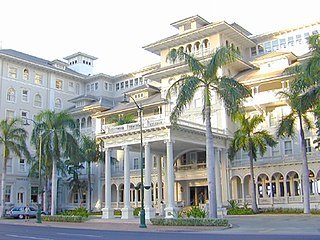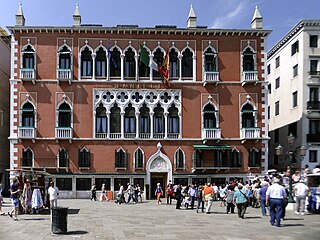
Hilton Hotels & Resorts is a global brand of full-service hotels and resorts and the flagship brand of American multinational hospitality company Hilton.

Starwood Hotels and Resorts Worldwide, Inc. was one of the largest companies that owned, operated, franchised and managed hotels, resorts, spas, residences, and vacation ownership properties. It was acquired by Marriott International in 2016. Starwood was founded in 1969 as a real estate investment trust. In 1995, it was acquired and reorganized by Barry Sternlicht, who was its chairman until 2005 and founder of the Starwood Capital Group. Starwood had 11 brands and owned, managed, or franchised 1,297 properties comprising 370,000 hotel rooms in approximately 100 countries.

The ʻIolani Palace was the royal residence of the rulers of the Kingdom of Hawaiʻi beginning with Kamehameha III under the Kamehameha Dynasty (1845) and ending with Queen Liliʻuokalani (1893) under the Kalākaua Dynasty, founded by her brother, King David Kalākaua. It is located in the capitol district of downtown Honolulu in the U.S. state of Hawaiʻi. It is now a National Historic Landmark listed on the National Register of Historic Places. After the monarchy was overthrown in 1893, the building was used as the capitol building for the Provisional Government, Republic, Territory, and State of Hawaiʻi until 1969. The palace was restored and opened to the public as a museum in 1978. ʻIolani Palace is the only royal palace on US soil.

The Moana Hotel is a historic hotel building in Honolulu, Hawaii, located at 2365 Kalākaua Avenue in the Waikiki neighborhood. Built in the late 19th century as the first hotel in Waikiki, the Moana opened in 1901. It is listed on the National Register of Historic Places. The hotel was also inducted into Historic Hotels of America, the official program of the National Trust for Historic Preservation, in 1989. The building is currently part of the resort complex known as Moana Surfrider, A Westin Resort & Spa and is managed by Westin Hotels & Resorts.
Marriott International, Inc. is an American multinational company that operates, franchises, and licenses lodging brands that include hotel, residential, and timeshare properties. Marriott International owns over 30 hotel and timeshare brands with 8,785 locations and 1,597,380 rooms across its network. Marriott International is headquartered in Bethesda, Maryland. The company was founded by J. Willard Marriott (1900–1985) and his wife Alice Marriott (1907–2000).

Ralston Hall Mansion located in Belmont, California, was the country house of William Chapman Ralston, a San Francisco businessman, a founder of the Bank of California, and a financier of the Comstock Lode. It is an opulent Italianate Villa, modified with touches of Steamboat Gothic and Victorian details. It is a California Historical Landmark and is designated a National Historic Landmark. It is now part of Notre Dame de Namur University.

William Chapman Ralston was a San Francisco businessman and financier, and the founder of the Bank of California.

The St. Regis New York is a historic luxury hotel at 2 East 55th Street, at the southeast corner with Fifth Avenue, in the Midtown Manhattan neighborhood of New York City. The hotel was originally developed by John Jacob Astor IV and was completed in 1904 to designs by Trowbridge & Livingston. An annex to the east was designed by Sloan & Robertson and completed in 1927. The hotel is operated by Marriott International and holds Forbes five-star and AAA five-diamond ratings. In addition, it is a New York City designated landmark.

The Hilton San Francisco Union Square is a skyscraper hotel located several blocks south-west of Union Square in San Francisco, California. Opened in 1964, the 18-story, 1200-room original building was known as a "motel within a hotel", allowing guests to park directly next to their upper-story rooms. Filling an entire city block, it remains one of the tallest structures representing Brutalist architecture, though it has been extensively altered since its construction. A second 46-story tower was added in 1971, while a third smaller 23-story connecting tower was completed in 1987. Renovated in 2017, it is the largest hotel on the West Coast, with 1,921 rooms.

The William Westerfeld House, also known as the "Russian Embassy", is a historic building located at 1198 Fulton Street in San Francisco, California, United States, across the street from the northwest corner of Alamo Square. Constructed for German-born confectioner William Westerfeld in 1889, the home is listed on the National Register of Historic Places and is San Francisco Landmark Number 135.

The Westin St. Francis, formerly known as St. Francis Hotel, is a hotel located on Powell and Geary Streets in San Francisco, adjacent to the whole western edge of Union Square. The two 12-story south wings of the hotel were built in 1904, and the double-width north wing was completed in 1913, initially as apartments for permanent guests. This section is referred to as the Landmark Building on the hotel's website. The 32-story, 120 m (390 ft) tower to the rear, referred to as the Tower Building, which was completed in 1972, features exterior glass elevators that offer panoramic views of the bay and the square below, making the St. Francis one of the largest hotels in the city, with more than 1,254 rooms and suites.

Albert Pissis (1852–1914) was a prolific Mexican-born American architect, of French and Mexican descent. He was active in San Francisco and had studied at the École des Beaux-Arts in Paris, France. He is credited with introducing the Beaux-Arts architectural style to San Francisco, California, designing a number of important buildings in the city in the years before and after the 1906 San Francisco earthquake.

Henry William Cleaveland was an American architect based in New York, New York, and then San Francisco, California, and Portland, Oregon. He was one of the founding members of the American Institute of Architects, and several of his works have been listed on the National Register of Historic Places. His works include Ralston Hall, a National Historic Landmark in the San Francisco Bay Area, the original Palace Hotel in San Francisco, and the Bidwell Mansion in Chico, California.

The Hotel Danieli is a palatial five-star hotel in Venice, Italy. The central wing of the hotel was built as the Palazzo Dandolo at the end of the 14th century, by one of the Dandolo families. CNN cites it as one of the top five "lavish hotels" in the city.

New Montgomery Street, formerly Montgomery Street South, begins at Market Street and terminates at Howard Street in the SOMA district of San Francisco, California.

The Phelan Building is an 11-story office building located at 760 Market Street in the Financial District of San Francisco, California. It has a triangular shape, similar to the Flatiron Building in Manhattan, New York City, with its tip at the meeting point of Market Street, O’Farrell Street, and Grant Avenue. It is a San Francisco Designated Landmark.

Kalākaua, the last king of Hawaii, died on January 20, 1891, while visiting in California. President Benjamin Harrison ordered the United States Navy and United States Army to conduct a state funeral in San Francisco. The funeral attracted an estimated 100,000 spectators who lined the streets to watch the cortege pass. When the United States military escorted his body back to Honolulu, no one knew Kalākaua had died. The homecoming celebration that Honolulu had been planning for their monarch was replaced by funeral preparations. He received a second state funeral in the throne room of Iolani Palace, entirely in the Hawaiian language, and was laid to rest at the Royal Mausoleum of Hawaii. News reports stated that the Honolulu funeral cortege was so massive it took 75 minutes for its entirety to pass any given point.

King Kalākaua of the Hawaiian Kingdom made a state visit to the United States during the period November 28, 1874, through February 3, 1875. Authorized by the legislature of Hawaii, the purpose of the visit was for the ratification of the reciprocity treaty. The 91-day round-trip journey across the United States began in Honolulu on November 17, 1874, and was completed on February 15, 1875. His arrival at San Francisco on November 28, made him the first reigning monarch of any nation to set foot in the United States. Upon his arrival in Washington, D.C., the United States Congress held the first joint meeting in the body's history, less formal than a joint session, to receive him. US President Ulysses S. Grant hosted him as honoree of the first state dinner at the White House.
The Monadnock Building is an historic 10-story, 204,625 square foot office building in downtown San Francisco, California located at 685 Market St. The building was designed by the firm of Frederick H. Meyer and Smith, and completed in 1907, immediately following the 1906 San Francisco earthquake. The building stands immediately adjacent to both the BART Montgomery Street Station and the Palace Hotel, and across Market Street from Lotta's Fountain.


































